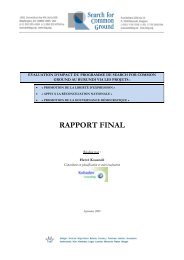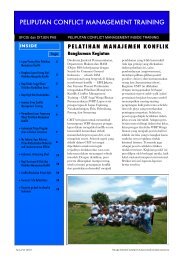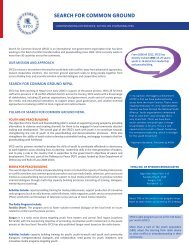notes - Search for Common Ground
notes - Search for Common Ground
notes - Search for Common Ground
Create successful ePaper yourself
Turn your PDF publications into a flip-book with our unique Google optimized e-Paper software.
• Utilizing SMS, radio, and other <strong>for</strong>ms of communication to reach rural and marginalized<br />
areas. Areas that may have high illiteracy rates.<br />
Comment: There are lots of critical issues and we are only highlighting a few critical issues. –<br />
Education, Employment,<br />
Q) Youth employment and livelihood – There have been a lot of programs with livelihood and<br />
many of these plans of implementation are too short. Example: 2011 tried to a vacation<br />
employment, the government didn’t pay in time and lots of riots broke out. Are there<br />
suggestions in how employment and livelihood programs can be improved?<br />
• A suggestion is to complete a situational analysis prior to implementation to find where<br />
youth want to work. Example: If youth don’t want to be tailors, then don’t train in this<br />
field. Also, what access to employment is available within that area? What will help<br />
better the society as a whole?<br />
• Donors – only want to learn what they already know and they are not thinking outside<br />
box. There needs to be a conversation with youth and the private sector. There are<br />
complaints about hiring outside. However, there could be training of youth <strong>for</strong> more jobs<br />
that are right there in their communities.<br />
• A Situation analysis would seek out the gaps happening between youth and donor<br />
agencies. Help to get true ideas of positive and long lasting solutions.<br />
Comment: Monitoring is obvious but necessary and is not being implemented.<br />
• There are vast gaps in actual work and results. For youth there is a gap in linking what<br />
they have learned to market and accompanying to starting in these positions.<br />
• Vocational training programs: It is critical that literacy accompanies vocational training.<br />
No complimentary skills, which are needed, are being taught in vocational training<br />
programs.<br />
• A suggestion is to set youth up with apprenticeships and co-ops and ensure challenges are<br />
met. This is not happening as most people are concerned with right now and not the long<br />
term effects of this process.<br />
Q) Unemployment is 60% to 70%. What is role of civil society in this process? Are we raising<br />
expectations and failing?<br />
• Incorporating relationships in bridging gap of private sector and youth training is needed.<br />
Filter in capturing needs. Making sure they have skills, not just entry level skills but<br />
skills to help them build upon towards a career path.<br />
• Having a realistic discussion with youth. Not all youth are going to get perfect jobs.<br />
How can we encourage them to relate more to them and be an active part of society?<br />
Encouraging support <strong>for</strong> programs that are working. Example: Training in classroom vs.<br />
programs with hands on experience. Help government funding go in the right direction..<br />
<strong>Search</strong> <strong>for</strong> <strong>Common</strong> <strong>Ground</strong><br />
6 | P age
















